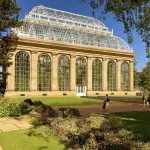Whittingehame Tower East Lothian Image, Old Property Refurbishment, Building Picture
Whittingehame Tower Restoration
Architecture in East Lothian, South East Scotland – Building Renewal by Ian Parsons Architect
post updated February 14, 2022
Summary
Whittingehame Tower Building Restoration
The work to Whittingehame Tower was carried out following the death of the 4th Earl, in June 2003. The work was phased to allow the new owner to move into the Tower as soon as possible, however, the two phases are part of one overall project. Snagging and additions to phase one continued until May 2006, most importantly the building services are common to both Phases.
Very little work had been undertaken at the Tower and its West Wing since a major series of alterations and the addition of a two storey harled extension, designed by Henry Wylie, in 1963. Much of this work no longer served its purpose. The fabric and rooms were outdated and the building services appeared to function but not to modern standards.
As a result of pressure on time it was decided to retain the 1960’s two storey extension, to carry out necessary fabric repairs and plan long term maintenance work. Existing services were to be upgraded where necessary, particularly with additional telecommunications circuits.
Conservation and Improvement Works to the Tower
Renewal of the Kitchen and Bathroom were priorities, with more sunlight in the Kitchen and direct access to the Garden through a sunroom or conservatory with underfloor heating. The form of a new Atrium was agreed at an early stage.
Historic Scotland and East Lothian Council advised that any new work should not encroach upon the West Wing. First floor windows and roof access requirements suggested a flat roof.
Internal changes involved the removal of worn 1960’s work and renewal of services only if necessary; the original intention was to cause a minimum of stripping-out. We were aware of the need for new service routes and puzzled that no Garde-robe chutes were known in the Tower. Cavities were found by physical exploration as floors and walls were opened up to replace wiring and pipework.
Removal of water storage tanks from the Caphouse at parapet level was important for conservation as previous leaks had threatened the First Floor ceiling. A pumped mains system was installed. The removal of external cast iron downpipes and vent pipes from the Tower walls was achieved by abandoning the combined drainage system and installing a new septic tank with a single SVP and separate rainwater disposal.
It was intended to retain the 1960’s MICC wiring which had an anticipated life of 100 years. As more and more surfaces were opened up to deal with rot or remove plumbing it was decided to completely replace the electrical system in PVC wiring, as contemporary requirements for computer and TV cabling could not be served by the 1960’s cables.
Central Heating and Hot Water systems were the key to many other decisions. On the Ground Floor, radiators were fed by steel pipework which was buried in the concrete slab. The Oil fired boiler was located 50 metres West on a system with no zone controls. The installation of underfloor heating with ceramic tiles was just possible by raising the Ground Floor by 100mm, the Tower Doors were high enough and 1960’s lintels could be raised. The central heating system was given additional circuits for zone control and pressurisation equipment allowed the removal of header tanks from the cap-house.
The Ground Floor of the Tower had no through ventilation and was damp. In addition to external drainage an electro-osmotic system was installed. Wires were raggled to mortar joints and are invisible; the system is highly effective and technically superior to such systems used in the 1960’s.
The Turnpike stair was unsafe as lighting was inadequate, changes in step height could not be seen and the rope handrail was insecure. Plaster had been stripped from the rubble walls, which were dusty and dark. A light coloured Lime based paint created a more effective use of light. The design solution sought to avoid raggling the stone for new wiring. Optical lighting fibres were carried in a 75mm Diameter steel handrail, formed on site to the irregular radius and stair pitch. Light boxes are concealed in accessible cavities found during the works; a lower level of lighting is used than normal as the light is directed onto stair treads; modern technology has been used to achieve the minimum of interference with the historic structure.
To facilitate access to and replacement of service runs in the West Wing the interior Library shelving and panelling was carefully removed at this stage, labelled and stored to be re-used when a new design had been agreed.
A more accurate assessment of the need to replace all 1960’s services at the start of the design process would have made the contractors work easier to plan. The flat roofed Atrium is a great success. Low level winter sun enters the Kitchen but high level summer sun is shaded, preventing the overheating and glare associated with conservatories.
Conservation and Improvement Works to the West Wing
The West Wing was used as a Laundry and ancillary accommodation and has none of the cultural significance of the Tower; architecturally the proposals are modest and referential to the Tower.
Replacement of the flat roof was the main improvement; other aspects of the fabric were sound. Internal work comprised the removal of 1960’s services and the creation of modern Bathrooms to form a guest wing. A new Garage was created to infill an empty space between the West Wing and Boiler Room.
The new Library interior received a great deal of care; the intention was to remove 1960’s Oak veneered plywood, but retain the fine solid Oak carving and shelving taken from Whittingehame House in the 1960’s. The Library had an open fire which was a focal point for the room but faced a corridor, gave out little heat and smoked frequently.
The new interior focussed a reduced area of solid oak panelling and shelving to the end walls of the long room and the fireplace was moved to its original position on an end wall; creating uninterrupted space around the fire. The Count Rumford fireplace design is more efficient than the BS throat profile and the vertical proportions are appropriate for rooms with a high ceiling.
The new roof was designed to have the same height and visual impact as the original parapet and slated roof, but at no greater cost than replacement roofing felt. The new materials could be used to form a planned Estate Office, which will terminate the West Wing.
An innovative design of door was designed for the Public areas. Initially a solid boarded oak door had been suggested but the client wanted a degree of transparency, particularly to allow the family dogs to see and be seen. After nine months of visits and study a design with structural hinges supporting vertical strips of Oak and Glass evolved which satisfied all criteria of visibility and the solidity required by the Tower.
The re-design was guided by Historic Scotland; new work is of modern construction but of modest form and colour to avoid competition with the Tower. The approach to the interior was that; there were many old things to be re-used and they would look more at home in a traditional setting –not displayed as old artefacts in modern surroundings.
The contractor, H.M. Raitt and Son, performed brilliantly with good planning and paperwork, good skills on site and a general attention to a tidy and safe site. I now have evidence to be able to argue in future that accepting the lowest tender may in the end be more expensive and slower than a better organised contractor with a higher tender.
Edinburgh Properties
Significant Edinburgh Architecture – Selection:
Scotland Street Lighting Edinburgh Restoration
Comments / photos for the Whittingehame Tower Architecture in East Lothian, near Edinburgh page welcome


